University Research Report: Diversity Management Methodology
VerifiedAdded on 2022/10/15
|7
|1524
|40
Report
AI Summary
This report details the research methodology employed to investigate the impact of diversity management practices on employee performance. The research utilizes an explanatory design to examine the cause-and-effect relationship between diversity practices and employee performance. Simple random sampling will be used to select 100 employees from five companies, and convenience sampling will be used to gather data from four managers. A mixed-methods approach will be employed, combining a quantitative questionnaire with 15 closed-ended questions for employees and qualitative interviews with managers using semi-structured open-ended questions. The study anticipates limitations such as biased responses and financial constraints. The research timeline follows a waterfall methodology, estimated to be completed in 90 days, and adheres to ethical considerations, including informed consent. The report also cites relevant academic sources to support the research design and methods.
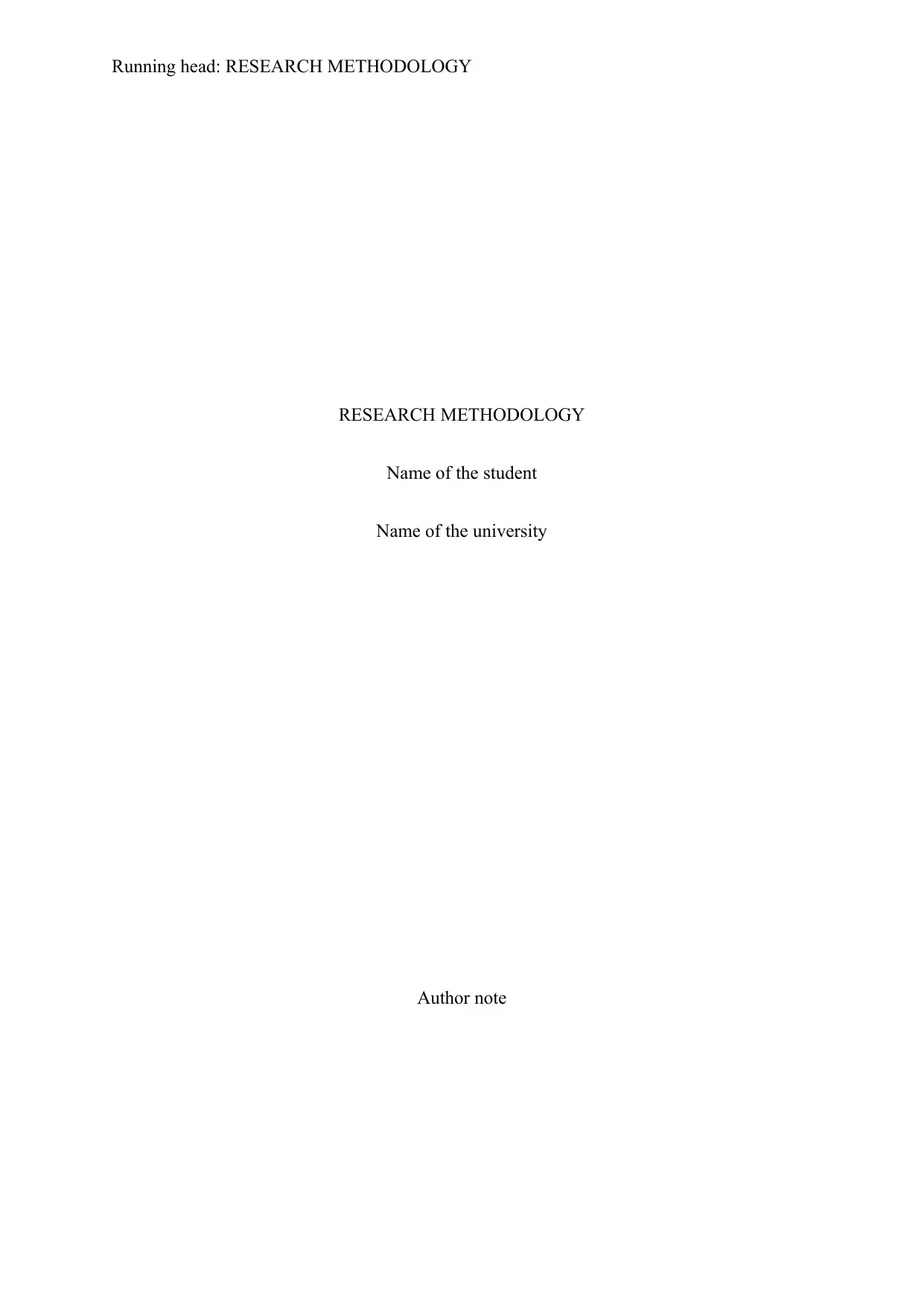
Running head: RESEARCH METHODOLOGY
RESEARCH METHODOLOGY
Name of the student
Name of the university
Author note
RESEARCH METHODOLOGY
Name of the student
Name of the university
Author note
Paraphrase This Document
Need a fresh take? Get an instant paraphrase of this document with our AI Paraphraser
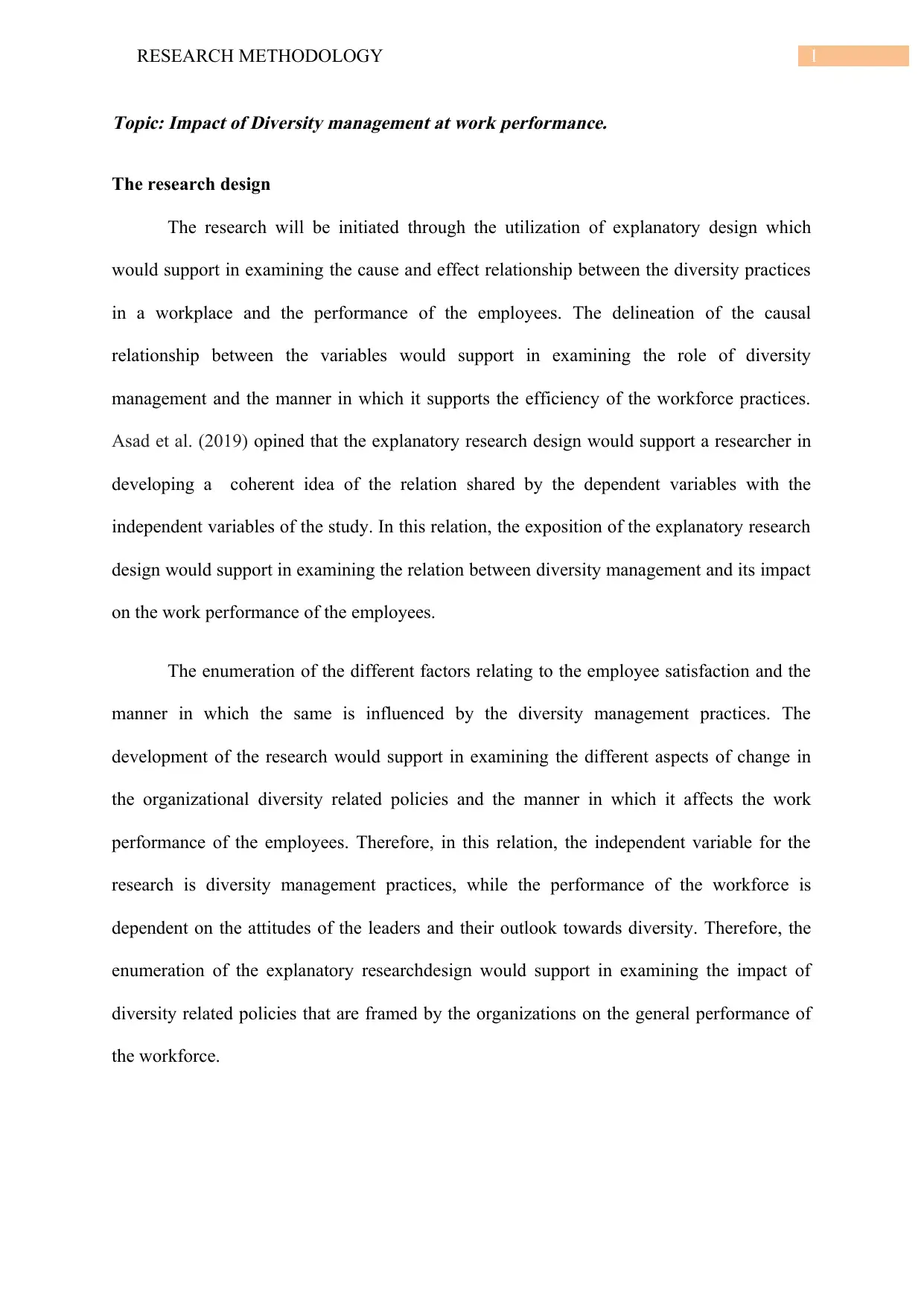
1RESEARCH METHODOLOGY
Topic: Impact of Diversity management at work performance.
The research design
The research will be initiated through the utilization of explanatory design which
would support in examining the cause and effect relationship between the diversity practices
in a workplace and the performance of the employees. The delineation of the causal
relationship between the variables would support in examining the role of diversity
management and the manner in which it supports the efficiency of the workforce practices.
Asad et al. (2019) opined that the explanatory research design would support a researcher in
developing a coherent idea of the relation shared by the dependent variables with the
independent variables of the study. In this relation, the exposition of the explanatory research
design would support in examining the relation between diversity management and its impact
on the work performance of the employees.
The enumeration of the different factors relating to the employee satisfaction and the
manner in which the same is influenced by the diversity management practices. The
development of the research would support in examining the different aspects of change in
the organizational diversity related policies and the manner in which it affects the work
performance of the employees. Therefore, in this relation, the independent variable for the
research is diversity management practices, while the performance of the workforce is
dependent on the attitudes of the leaders and their outlook towards diversity. Therefore, the
enumeration of the explanatory researchdesign would support in examining the impact of
diversity related policies that are framed by the organizations on the general performance of
the workforce.
Topic: Impact of Diversity management at work performance.
The research design
The research will be initiated through the utilization of explanatory design which
would support in examining the cause and effect relationship between the diversity practices
in a workplace and the performance of the employees. The delineation of the causal
relationship between the variables would support in examining the role of diversity
management and the manner in which it supports the efficiency of the workforce practices.
Asad et al. (2019) opined that the explanatory research design would support a researcher in
developing a coherent idea of the relation shared by the dependent variables with the
independent variables of the study. In this relation, the exposition of the explanatory research
design would support in examining the relation between diversity management and its impact
on the work performance of the employees.
The enumeration of the different factors relating to the employee satisfaction and the
manner in which the same is influenced by the diversity management practices. The
development of the research would support in examining the different aspects of change in
the organizational diversity related policies and the manner in which it affects the work
performance of the employees. Therefore, in this relation, the independent variable for the
research is diversity management practices, while the performance of the workforce is
dependent on the attitudes of the leaders and their outlook towards diversity. Therefore, the
enumeration of the explanatory researchdesign would support in examining the impact of
diversity related policies that are framed by the organizations on the general performance of
the workforce.
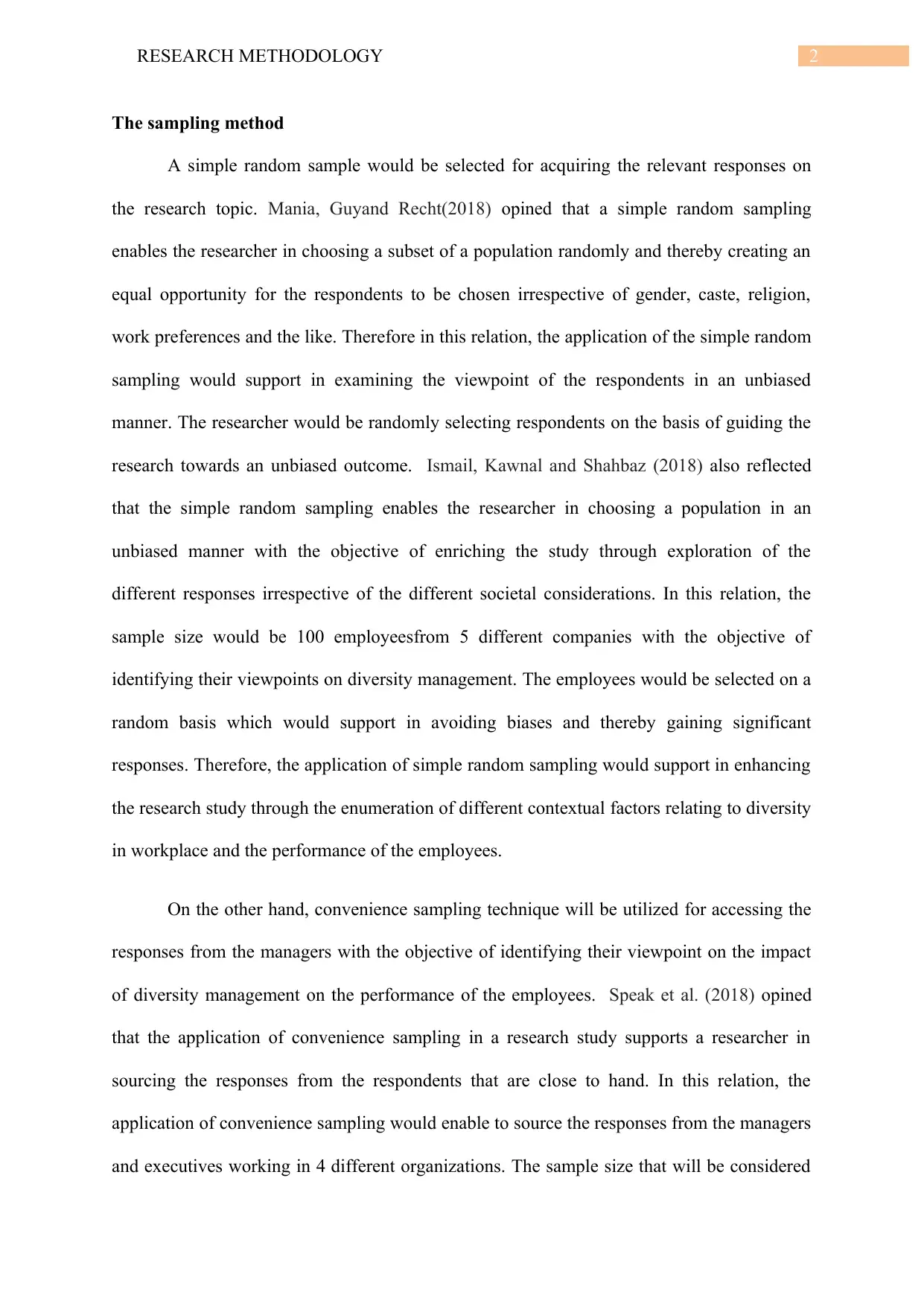
2RESEARCH METHODOLOGY
The sampling method
A simple random sample would be selected for acquiring the relevant responses on
the research topic. Mania, Guyand Recht(2018) opined that a simple random sampling
enables the researcher in choosing a subset of a population randomly and thereby creating an
equal opportunity for the respondents to be chosen irrespective of gender, caste, religion,
work preferences and the like. Therefore in this relation, the application of the simple random
sampling would support in examining the viewpoint of the respondents in an unbiased
manner. The researcher would be randomly selecting respondents on the basis of guiding the
research towards an unbiased outcome. Ismail, Kawnal and Shahbaz (2018) also reflected
that the simple random sampling enables the researcher in choosing a population in an
unbiased manner with the objective of enriching the study through exploration of the
different responses irrespective of the different societal considerations. In this relation, the
sample size would be 100 employeesfrom 5 different companies with the objective of
identifying their viewpoints on diversity management. The employees would be selected on a
random basis which would support in avoiding biases and thereby gaining significant
responses. Therefore, the application of simple random sampling would support in enhancing
the research study through the enumeration of different contextual factors relating to diversity
in workplace and the performance of the employees.
On the other hand, convenience sampling technique will be utilized for accessing the
responses from the managers with the objective of identifying their viewpoint on the impact
of diversity management on the performance of the employees. Speak et al. (2018) opined
that the application of convenience sampling in a research study supports a researcher in
sourcing the responses from the respondents that are close to hand. In this relation, the
application of convenience sampling would enable to source the responses from the managers
and executives working in 4 different organizations. The sample size that will be considered
The sampling method
A simple random sample would be selected for acquiring the relevant responses on
the research topic. Mania, Guyand Recht(2018) opined that a simple random sampling
enables the researcher in choosing a subset of a population randomly and thereby creating an
equal opportunity for the respondents to be chosen irrespective of gender, caste, religion,
work preferences and the like. Therefore in this relation, the application of the simple random
sampling would support in examining the viewpoint of the respondents in an unbiased
manner. The researcher would be randomly selecting respondents on the basis of guiding the
research towards an unbiased outcome. Ismail, Kawnal and Shahbaz (2018) also reflected
that the simple random sampling enables the researcher in choosing a population in an
unbiased manner with the objective of enriching the study through exploration of the
different responses irrespective of the different societal considerations. In this relation, the
sample size would be 100 employeesfrom 5 different companies with the objective of
identifying their viewpoints on diversity management. The employees would be selected on a
random basis which would support in avoiding biases and thereby gaining significant
responses. Therefore, the application of simple random sampling would support in enhancing
the research study through the enumeration of different contextual factors relating to diversity
in workplace and the performance of the employees.
On the other hand, convenience sampling technique will be utilized for accessing the
responses from the managers with the objective of identifying their viewpoint on the impact
of diversity management on the performance of the employees. Speak et al. (2018) opined
that the application of convenience sampling in a research study supports a researcher in
sourcing the responses from the respondents that are close to hand. In this relation, the
application of convenience sampling would enable to source the responses from the managers
and executives working in 4 different organizations. The sample size that will be considered
⊘ This is a preview!⊘
Do you want full access?
Subscribe today to unlock all pages.

Trusted by 1+ million students worldwide
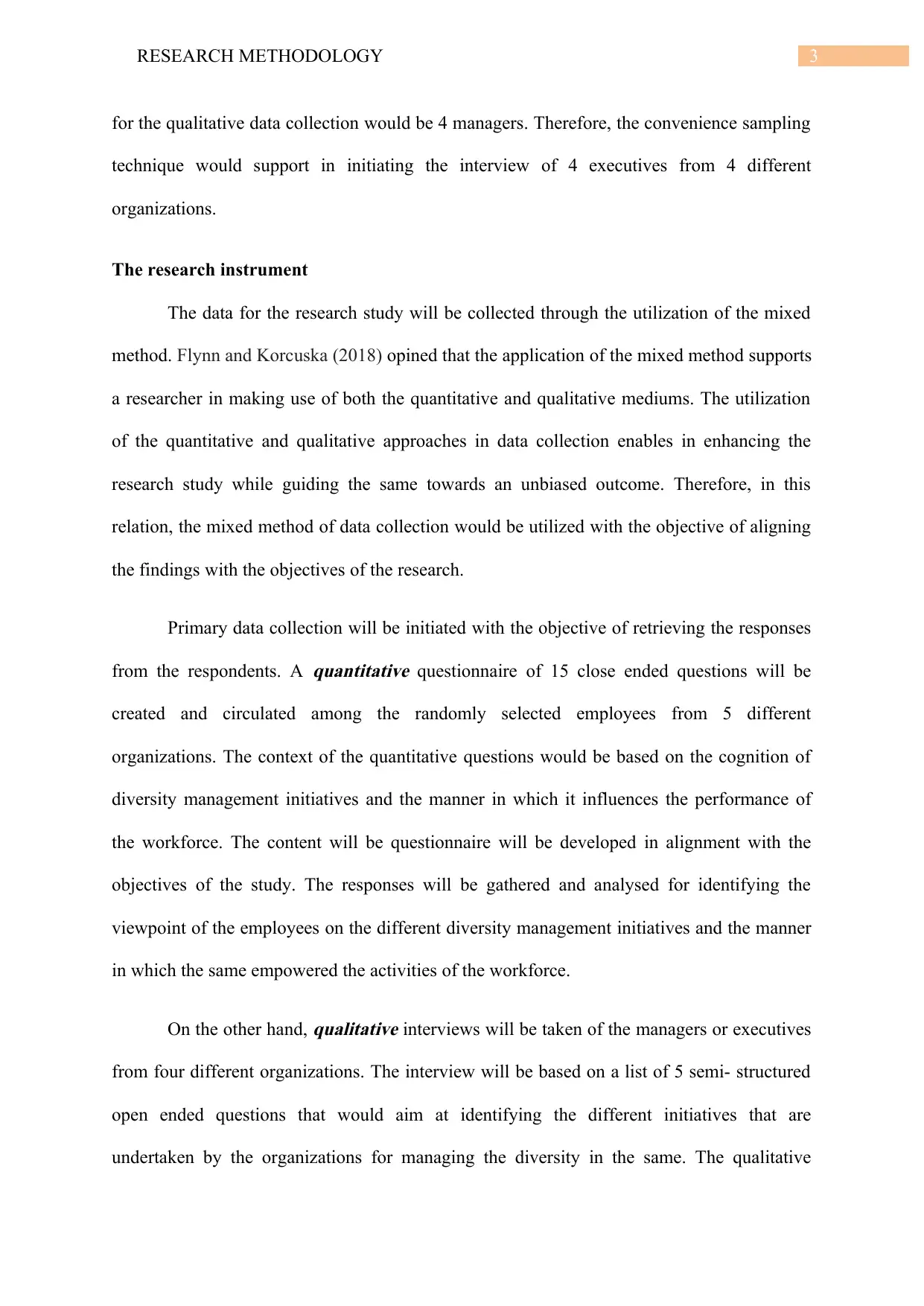
3RESEARCH METHODOLOGY
for the qualitative data collection would be 4 managers. Therefore, the convenience sampling
technique would support in initiating the interview of 4 executives from 4 different
organizations.
The research instrument
The data for the research study will be collected through the utilization of the mixed
method. Flynn and Korcuska (2018) opined that the application of the mixed method supports
a researcher in making use of both the quantitative and qualitative mediums. The utilization
of the quantitative and qualitative approaches in data collection enables in enhancing the
research study while guiding the same towards an unbiased outcome. Therefore, in this
relation, the mixed method of data collection would be utilized with the objective of aligning
the findings with the objectives of the research.
Primary data collection will be initiated with the objective of retrieving the responses
from the respondents. A
quantitative questionnaire of 15 close ended questions will be
created and circulated among the randomly selected employees from 5 different
organizations. The context of the quantitative questions would be based on the cognition of
diversity management initiatives and the manner in which it influences the performance of
the workforce. The content will be questionnaire will be developed in alignment with the
objectives of the study. The responses will be gathered and analysed for identifying the
viewpoint of the employees on the different diversity management initiatives and the manner
in which the same empowered the activities of the workforce.
On the other hand,
qualitative interviews will be taken of the managers or executives
from four different organizations. The interview will be based on a list of 5 semi- structured
open ended questions that would aim at identifying the different initiatives that are
undertaken by the organizations for managing the diversity in the same. The qualitative
for the qualitative data collection would be 4 managers. Therefore, the convenience sampling
technique would support in initiating the interview of 4 executives from 4 different
organizations.
The research instrument
The data for the research study will be collected through the utilization of the mixed
method. Flynn and Korcuska (2018) opined that the application of the mixed method supports
a researcher in making use of both the quantitative and qualitative mediums. The utilization
of the quantitative and qualitative approaches in data collection enables in enhancing the
research study while guiding the same towards an unbiased outcome. Therefore, in this
relation, the mixed method of data collection would be utilized with the objective of aligning
the findings with the objectives of the research.
Primary data collection will be initiated with the objective of retrieving the responses
from the respondents. A
quantitative questionnaire of 15 close ended questions will be
created and circulated among the randomly selected employees from 5 different
organizations. The context of the quantitative questions would be based on the cognition of
diversity management initiatives and the manner in which it influences the performance of
the workforce. The content will be questionnaire will be developed in alignment with the
objectives of the study. The responses will be gathered and analysed for identifying the
viewpoint of the employees on the different diversity management initiatives and the manner
in which the same empowered the activities of the workforce.
On the other hand,
qualitative interviews will be taken of the managers or executives
from four different organizations. The interview will be based on a list of 5 semi- structured
open ended questions that would aim at identifying the different initiatives that are
undertaken by the organizations for managing the diversity in the same. The qualitative
Paraphrase This Document
Need a fresh take? Get an instant paraphrase of this document with our AI Paraphraser
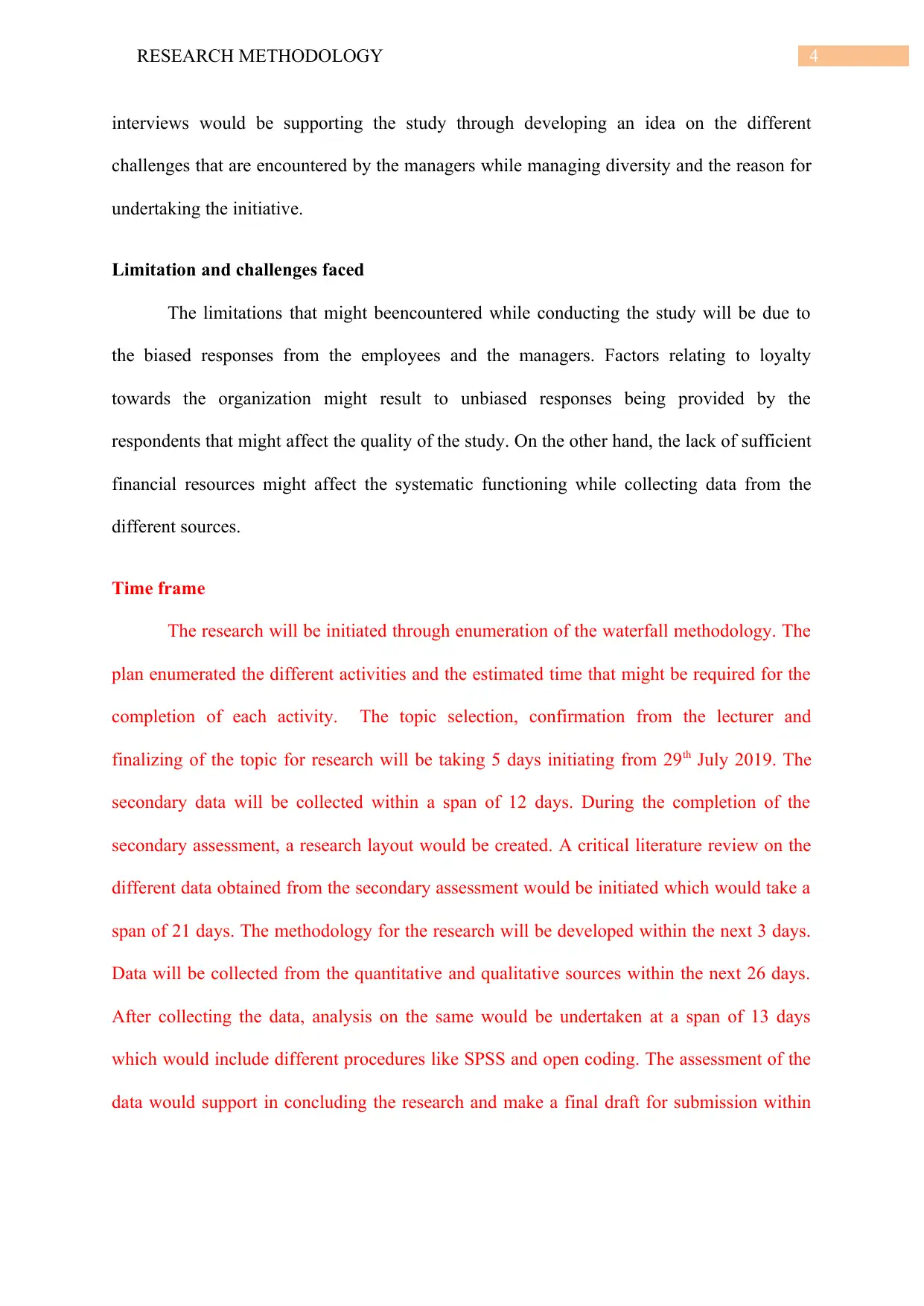
4RESEARCH METHODOLOGY
interviews would be supporting the study through developing an idea on the different
challenges that are encountered by the managers while managing diversity and the reason for
undertaking the initiative.
Limitation and challenges faced
The limitations that might beencountered while conducting the study will be due to
the biased responses from the employees and the managers. Factors relating to loyalty
towards the organization might result to unbiased responses being provided by the
respondents that might affect the quality of the study. On the other hand, the lack of sufficient
financial resources might affect the systematic functioning while collecting data from the
different sources.
Time frame
The research will be initiated through enumeration of the waterfall methodology. The
plan enumerated the different activities and the estimated time that might be required for the
completion of each activity. The topic selection, confirmation from the lecturer and
finalizing of the topic for research will be taking 5 days initiating from 29th July 2019. The
secondary data will be collected within a span of 12 days. During the completion of the
secondary assessment, a research layout would be created. A critical literature review on the
different data obtained from the secondary assessment would be initiated which would take a
span of 21 days. The methodology for the research will be developed within the next 3 days.
Data will be collected from the quantitative and qualitative sources within the next 26 days.
After collecting the data, analysis on the same would be undertaken at a span of 13 days
which would include different procedures like SPSS and open coding. The assessment of the
data would support in concluding the research and make a final draft for submission within
interviews would be supporting the study through developing an idea on the different
challenges that are encountered by the managers while managing diversity and the reason for
undertaking the initiative.
Limitation and challenges faced
The limitations that might beencountered while conducting the study will be due to
the biased responses from the employees and the managers. Factors relating to loyalty
towards the organization might result to unbiased responses being provided by the
respondents that might affect the quality of the study. On the other hand, the lack of sufficient
financial resources might affect the systematic functioning while collecting data from the
different sources.
Time frame
The research will be initiated through enumeration of the waterfall methodology. The
plan enumerated the different activities and the estimated time that might be required for the
completion of each activity. The topic selection, confirmation from the lecturer and
finalizing of the topic for research will be taking 5 days initiating from 29th July 2019. The
secondary data will be collected within a span of 12 days. During the completion of the
secondary assessment, a research layout would be created. A critical literature review on the
different data obtained from the secondary assessment would be initiated which would take a
span of 21 days. The methodology for the research will be developed within the next 3 days.
Data will be collected from the quantitative and qualitative sources within the next 26 days.
After collecting the data, analysis on the same would be undertaken at a span of 13 days
which would include different procedures like SPSS and open coding. The assessment of the
data would support in concluding the research and make a final draft for submission within
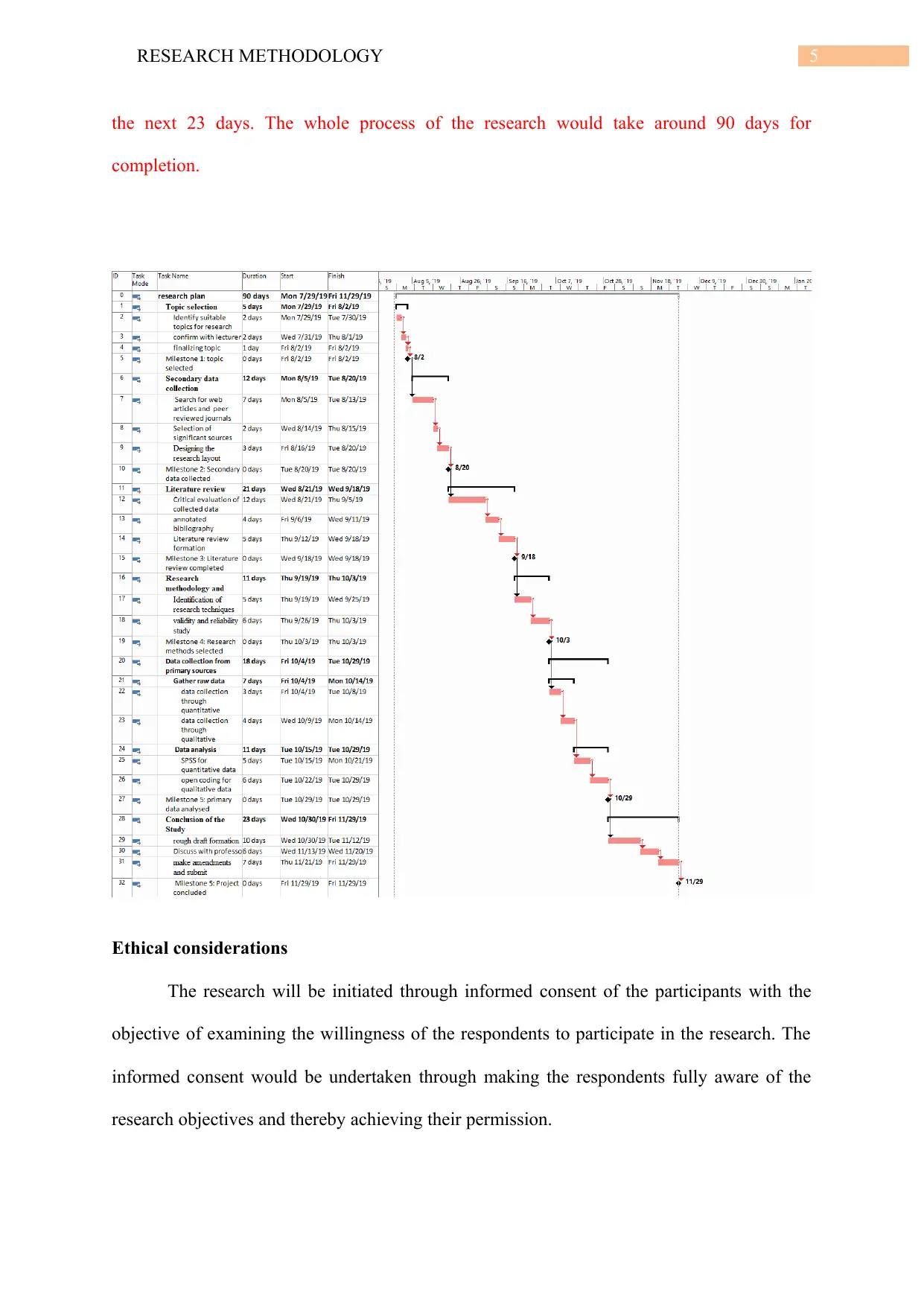
5RESEARCH METHODOLOGY
the next 23 days. The whole process of the research would take around 90 days for
completion.
Ethical considerations
The research will be initiated through informed consent of the participants with the
objective of examining the willingness of the respondents to participate in the research. The
informed consent would be undertaken through making the respondents fully aware of the
research objectives and thereby achieving their permission.
the next 23 days. The whole process of the research would take around 90 days for
completion.
Ethical considerations
The research will be initiated through informed consent of the participants with the
objective of examining the willingness of the respondents to participate in the research. The
informed consent would be undertaken through making the respondents fully aware of the
research objectives and thereby achieving their permission.
⊘ This is a preview!⊘
Do you want full access?
Subscribe today to unlock all pages.

Trusted by 1+ million students worldwide
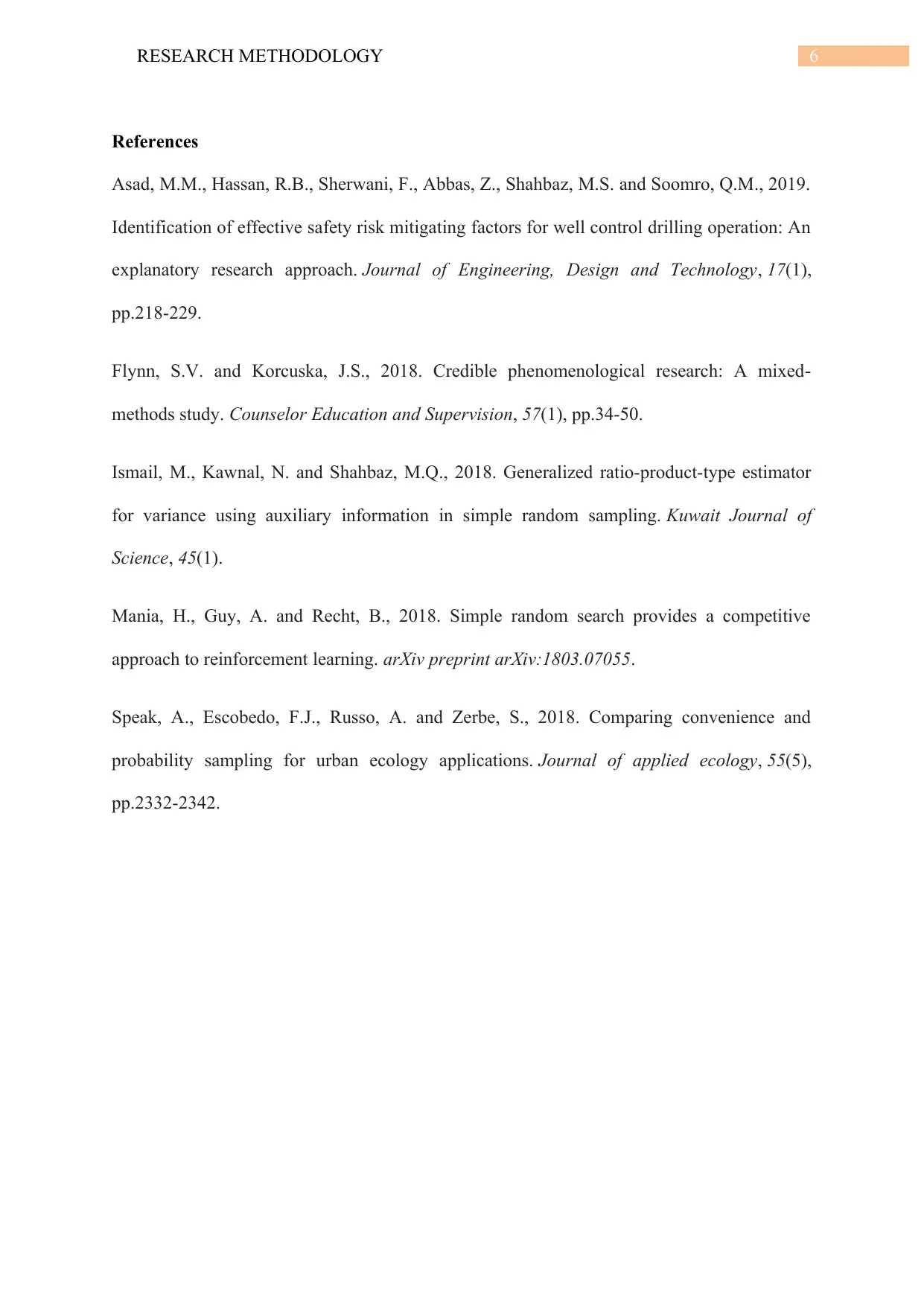
6RESEARCH METHODOLOGY
References
Asad, M.M., Hassan, R.B., Sherwani, F., Abbas, Z., Shahbaz, M.S. and Soomro, Q.M., 2019.
Identification of effective safety risk mitigating factors for well control drilling operation: An
explanatory research approach. Journal of Engineering, Design and Technology, 17(1),
pp.218-229.
Flynn, S.V. and Korcuska, J.S., 2018. Credible phenomenological research: A mixed‐
methods study. Counselor Education and Supervision, 57(1), pp.34-50.
Ismail, M., Kawnal, N. and Shahbaz, M.Q., 2018. Generalized ratio-product-type estimator
for variance using auxiliary information in simple random sampling. Kuwait Journal of
Science, 45(1).
Mania, H., Guy, A. and Recht, B., 2018. Simple random search provides a competitive
approach to reinforcement learning. arXiv preprint arXiv:1803.07055.
Speak, A., Escobedo, F.J., Russo, A. and Zerbe, S., 2018. Comparing convenience and
probability sampling for urban ecology applications. Journal of applied ecology, 55(5),
pp.2332-2342.
References
Asad, M.M., Hassan, R.B., Sherwani, F., Abbas, Z., Shahbaz, M.S. and Soomro, Q.M., 2019.
Identification of effective safety risk mitigating factors for well control drilling operation: An
explanatory research approach. Journal of Engineering, Design and Technology, 17(1),
pp.218-229.
Flynn, S.V. and Korcuska, J.S., 2018. Credible phenomenological research: A mixed‐
methods study. Counselor Education and Supervision, 57(1), pp.34-50.
Ismail, M., Kawnal, N. and Shahbaz, M.Q., 2018. Generalized ratio-product-type estimator
for variance using auxiliary information in simple random sampling. Kuwait Journal of
Science, 45(1).
Mania, H., Guy, A. and Recht, B., 2018. Simple random search provides a competitive
approach to reinforcement learning. arXiv preprint arXiv:1803.07055.
Speak, A., Escobedo, F.J., Russo, A. and Zerbe, S., 2018. Comparing convenience and
probability sampling for urban ecology applications. Journal of applied ecology, 55(5),
pp.2332-2342.
1 out of 7
Related Documents
Your All-in-One AI-Powered Toolkit for Academic Success.
+13062052269
info@desklib.com
Available 24*7 on WhatsApp / Email
![[object Object]](/_next/static/media/star-bottom.7253800d.svg)
Unlock your academic potential
Copyright © 2020–2025 A2Z Services. All Rights Reserved. Developed and managed by ZUCOL.





